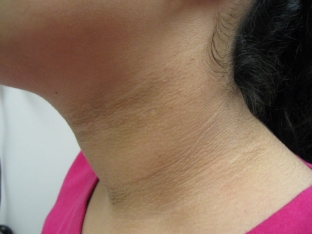Acanthosis nigricans was described in the 9th century and is considered quite rare. The development of acanthosis is accompanied by the appearance of areas of hyperkeratosis in the area of natural skin folds. In these areas, increased pigmentation and skin papillomatosis are found. Large skin folds are usually affected - armpits, groin and neck. Timely detection of acanthosis in the early stages can indicate & nbsp; serious processes. What is dangerous acanthosis and how to recognize it, read on estet-portal. com.
Main causes of acanthosis nigricans
Acanthosis nigricans can develop in a person of any gender and age, and the causes are individual and specific for each patient.
Predisposing factors for the development of acanthosis nigricans are:
- Pathologies in the work of the endocrine organs.
- Malignant neoplasms provoke many complex biochemical reactions and reactions of the immune system. Men are prone to acanthosis in the presence of pancreatic cancer, prostate cancer, women in the presence of ovarian and breast cancer.
- Heredity affects the development of acanthosis. With metabolic disorders and mental inferiority, which are caused by hereditary pathology, for example, with Rude and Miescher syndromes, acanthosis develops.
- Taking estrogen hormones and certain other medications.
So, in young people, the causes of acanthosis are often obesity, endocrine disorders and genetic pathologies, in older people, the causes are often neoplasms.
What symptoms would indicate acanthosis? Forms of black acanthosis
Acanthosis has several forms of flow, depending on the cause, which determines intensity of process development. Dermatologists have identified 3 main forms of the course of black acanthosis:
- Juvenile or benign, which is associated with endocrine and genetic pathologies.
- Malignant or paraneoplastic, which develops with malignant tumors of the internal organs.
- Pseudo-acanthosis, which develops with obesity and metabolic disorders. This form disappears without a trace when the weight normalizes, has the best prognosis.
The clinical manifestations of acanthosis have 3 main symptoms:
- Increased pigmentation – the appearance of black or dark brown spots on the skin.
- Papillomatosis - the presence of fibromas or papillomas on the skin, which is popularly called warts.
- Hyperkeratosis, which causes rough and flaky skin.

Localization acanthosis on the skin. What symptoms accompany the progression of acanthosis?
The above skin changes are most often found on the skin of the inguinal-femoral fold, intergluteal region, elbows, on the crease between the back of the head and neck, on the skin of the armpits, in the popliteal region, on the skin under the mammary glands. It is possible that the triad of symptoms will appear on other parts of the body (face, lateral surface of the neck and umbilical region).
In the early stages of development of acanthosis, the patient's skin gradually darkens. Many people try to wash their skin thoroughly, thinking that it is dirty. As the disease progresses, the skin begins to darken even more, becomes rough, dry, and thickens. The natural pattern of the skin becomes more pronounced and deep.
In the later stages, growths in the form of fibromas and small papillomas appear on the affected areas of the skin. The growths are papillary in shape and arranged in dense rows, giving the skin a warty appearance. These formations may also be hyperpigmented. All symptoms of acanthosis on the skin are accompanied by slight itching and tingling. There is no hairline on the affected areas of the skin.
What are the aspects of diagnosis and treatment of acanthosis nigricans?
If darkening of the skin is detected in certain areas of the skin, which does not go away, but only progresses, it is worth contacting a dermatologist. The specialist will conduct a differential diagnosis with Addison's disease, ichthyosis, Darier's disease. The final diagnosis of black acanthosis is established on the basis of histological examination of the biopsy. If a malignant form is suspected, an oncologist consultation is required.
Treatment includes therapy for the underlying disease that led to acanthosis and symptomatic therapy. Assign restorative drugs, vitamin complexes, anti-inflammatory ointments, baths with potassium permanganate, zinc preparations, aromatic retinoids. In severe cases - cytostatics and hormonal drugs, neurotropic drugs, antibiotic therapy. All this must be accompanied by diet.
In case of massive growths of papillomas, they are surgically removed using cryodestruction or electrocoagulation.
Thus, behind a simple darkening of the skin, the course of the oncological process can be hidden, which is not yet manifested by general symptoms, but only by acanthosis. Therefore, contacting a doctor if acanthosis is suspected can improve the prognosis of the course of pathological processes.






Add a comment